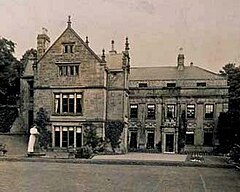Brymbo Hall
| Brymbo Hall | |
|---|---|

Eastern side of the house, taken in 1908
|
|
| General information | |
| Architectural style | Some Baroque / Palladian elements |
| Town or city | Brymbo, Denbighshire |
| Country | Wales |
| Coordinates | 53°04′22″N 3°03′22″W / 53.072780°N 3.056029°WCoordinates: 53°04′22″N 3°03′22″W / 53.072780°N 3.056029°W |
| Completed | 1624 (part) |
| Demolished | 1973 |
| Design and construction | |
| Architect | Inigo Jones (attrib.) |
Brymbo Hall, one of Britain's lost houses, was a manor house located near Brymbo outside the town of Wrexham, North Wales. The house, reputed to have been partly built to the designs of Inigo Jones, was noted as the residence of 18th-century industrialist and ironmaster John "Iron-Mad" Wilkinson.
The estate was located on the upland moors around 3 miles (4.8 km) north-west of Wrexham. Its early history was relatively obscure, the deeds having been destroyed in a fire in 1794, though it was thought a house on the site had been constructed in the late 15th century for Edward ap Morgan ap Madoc, gentleman. Edward's son, Gruffydd, founded the locally-prominent Griffith family in the early 16th century, and a more modern house was built in 1624 for Edward's descendant John Griffith.
A persistent local tradition claimed that not only had Inigo Jones designed the 1624 building, but that he had been born at the old Brymbo Hall (little is recorded of Jones's early life but he is generally thought to have been born in London, though he was of Welsh descent). However, a portico at the house dated 1624 was more firmly attributed to the architect, though it was later noted that the aedicular doorway was in fact a copy of Plate 158 in Sebastiano Serlio's Fourth Book, the Regole generali d'architettura (1537). Jones was also considered to have designed the chapel set in the grounds of the house. The main 1624 building was later extended by an eastern wing featuring a giant order of Doric pilasters.
In 1649 Brymbo Hall was acquired by Sir Richard Saltonstall, an early settler in New England, on his return to Britain. By the close of the 17th century it was again occupied by the Griffith family, being owned by Robert Griffith, Esq, who served as High Sheriff of Denbighshire in 1684-5. Robert's only son John matriculated from Christ Church, Oxford in 1695, aged 18; but appears to have died, without issue, before his parents, as the property was inherited by Robert's daughter Mary. As a highly marrieageable heiress, Mary married Robert Jeffreys of Acton Hall and after his death married again, to Richard Clayton of Lea Hall in Shropshire. She then married a third time, to Arthur Owen, a member of the Owen family of Brogyntyn. Her daughter Jane Clayton married Watkin Wynne of Voelas; their daughter, Elizabeth Wynne, married Thomas Assheton Smith I. During the mid-18th century the estate was the subject of several lawsuits between relatives of Arthur Owen and Richard Clayton.
...
Wikipedia
